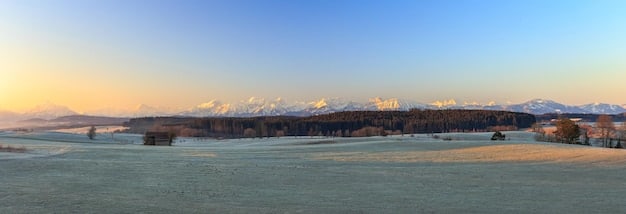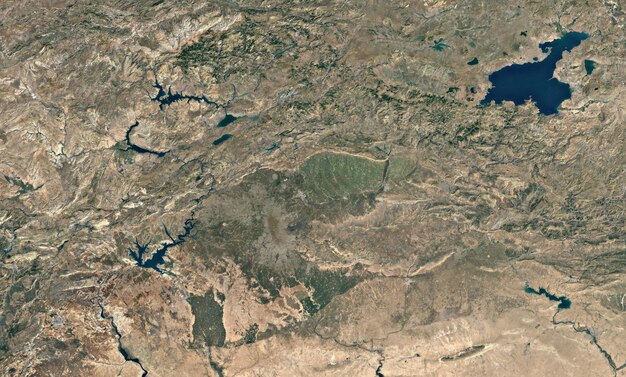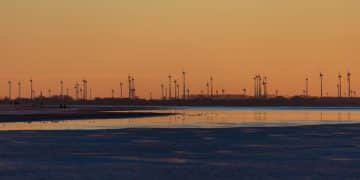Melting Glaciers: How Western US Agriculture Faces Water Crisis

Melting glaciers significantly threaten the water supply for Western US agriculture, potentially leading to reduced crop yields, economic losses, and increased competition for water resources within the next five years.
The clock is ticking for Western US agriculture as melting glaciers accelerate, jeopardizing the reliable water supply crucial for irrigation and crop production in the next 5 years.
Melting Glaciers and the Looming Water Crisis
Glaciers in the Western United States are disappearing at an alarming rate due to climate change. This is not just an environmental issue; it’s a direct threat to the agricultural sector, which relies heavily on snowmelt for irrigation.
Understanding the implications of this water shortage is crucial for farmers, policymakers, and consumers alike. Without proactive measures, the future of Western US agriculture is at stake.
The Vital Role of Glaciers in Western US Water Supply
Glaciers act as natural reservoirs, storing water during the winter months as snow and ice, and releasing it gradually during the spring and summer when demand is highest. This reliable meltwater sustains rivers and aquifers, providing a critical water source for farms and communities.
As these glaciers shrink, the timing and quantity of water available for irrigation are changing, leading to increased uncertainty and stress on agricultural systems.
Glacial Melt Dynamics
The rate at which glaciers melt is influenced by several factors, including temperature, precipitation patterns, and the size and altitude of the glacier. Rising temperatures have accelerated the melting process, leading to a net loss of glacial ice mass.
This loss is particularly pronounced in the Western US, where many glaciers are relatively small and vulnerable to warming temperatures.
Impact on River Flows
Glacial meltwater contributes significantly to the flow of major rivers in the West, such as the Colorado River, the Columbia River, and the Sacramento River. These rivers are essential for irrigating crops and supporting agricultural activities in the region.
Reduced glacial meltwater will lead to lower river flows, straining water supplies and increasing competition among different users.

- Decreasing Snowpack: Warmer temperatures lead to less snow accumulation in the winter, reducing the amount of water stored as snowpack.
- Earlier Runoff: Snow melts earlier in the spring, leading to a shorter irrigation season and reduced water availability later in the summer.
- Increased Evaporation: Higher temperatures increase evaporation rates, further reducing water supplies.
The consequences of reduced glacial meltwater are far-reaching, affecting crop production, livestock grazing, and the overall economic viability of agricultural communities in the Western US.
Projected Reductions in Water Availability
Climate models project significant reductions in water availability in the Western US over the next several decades. These reductions are expected to be particularly severe in the Southwest, where water resources are already scarce.
The agricultural sector will bear the brunt of these water shortages, facing difficult choices about which crops to grow and how to manage limited water supplies.
Quantifying the Decline
Studies have estimated that glacial meltwater could decline by as much as 50% by the middle of the century. This decline will have a significant impact on the amount of water available for irrigation, particularly during the peak growing season.
The exact amount of the decline will vary depending on the region and the specific glacier, but the overall trend is clear: water availability is decreasing.
Regional Variations
The impact of reduced water availability will vary across different regions of the Western US. Some areas, such as the Pacific Northwest, may be less affected due to higher precipitation rates. However, other areas, such as the Southwest, will face severe water shortages that could threaten the viability of agriculture.
Understanding these regional variations is crucial for developing targeted adaptation strategies.

- Increased Drought Frequency: Reduced water availability will exacerbate the frequency and severity of droughts, further straining water resources.
- Competition for Water: As water becomes scarcer, competition will increase among different users, including agriculture, municipalities, and industry.
- Economic Consequences: Water shortages will lead to reduced crop yields, higher food prices, and economic losses for farmers and communities.
Addressing the projected reductions in water availability will require a multi-faceted approach, including water conservation, improved irrigation techniques, and investments in water infrastructure.
Impacts on Key Agricultural Sectors
The agricultural sector in the Western US is diverse, ranging from fruit and vegetable production to livestock grazing and grain farming. Reduced water availability will have different impacts on these various sectors, depending on their water needs and the specific crops they grow.
Understanding these impacts is essential for developing strategies to mitigate the effects of water shortages.
Crop Production
Many crops grown in the West, such as almonds, grapes, and lettuce, are heavily reliant on irrigation. Reduced water availability will lead to lower yields, reduced crop quality, and increased production costs.
Farmers may be forced to switch to less water-intensive crops or fallow land to conserve water.
Livestock Grazing
Livestock grazing also relies on water resources, both for drinking water and for irrigating pastureland. Reduced water availability will limit the availability of forage, reducing the carrying capacity of rangelands and impacting livestock production.
Farmers will need to adopt sustainable grazing practices to conserve water and protect rangeland ecosystems.
Economic Ripple Effects
The impacts on key agricultural sectors will have ripple effects throughout the economy, affecting food prices, employment rates, and the overall economic health of rural communities.
Policymakers need to consider these ripple effects when developing policies to address water shortages.
The agricultural sector in the Western US is facing a significant challenge due to reduced water availability. By understanding the impacts on key sectors and adopting proactive measures, farmers and policymakers can work together to mitigate the effects of water shortages and ensure the long-term sustainability of agriculture in the region.
Adaptation Strategies for Western US Agriculture
To cope with the challenges of reduced water availability, Western US agriculture needs to implement a range of adaptation strategies. These strategies include water conservation, improved irrigation techniques, and investments in water infrastructure.
By adopting these strategies, farmers can reduce their water consumption, increase their resilience to drought, and ensure the long-term sustainability of their operations.
Water Conservation Techniques
Water conservation is the first line of defense against water shortages. Farmers can adopt a variety of techniques to reduce their water consumption, including using drought-resistant crops, improving irrigation efficiency, and implementing soil moisture monitoring systems.
These techniques can significantly reduce the amount of water needed to grow crops and support livestock.
Improved Irrigation Technologies
Traditional irrigation methods, such as flood irrigation, are often inefficient, losing a significant amount of water to evaporation and runoff. Improved irrigation technologies, such as drip irrigation and micro-sprinklers, can deliver water directly to the roots of plants, reducing water waste and increasing crop yields.
Investing in these technologies can significantly improve water use efficiency.
- Water Storage: Building or expanding water storage facilities can help farmers capture and store water during wet periods for use during dry periods.
- Water Reuse: Reusing treated wastewater for irrigation can provide a reliable source of water for agriculture, reducing pressure on freshwater supplies.
- Crop Diversification: Diversifying crop portfolios can help farmers reduce their reliance on water-intensive crops and increase their resilience to drought.
The adaptation strategies for Western US agriculture are diverse, ranging from water conservation techniques to improved irrigation technologies and strategic investments. By adopting these strategies, farmers can mitigate water shortages and ensure sustainable operations.
Policy Implications and Future Outlook
The challenges facing Western US agriculture require a comprehensive policy response. Policymakers need to develop and implement policies that promote water conservation, improve water infrastructure, and support adaptation strategies for farmers.
By working together, policymakers and farmers can ensure the long-term sustainability of agriculture in the region.
Incentives for Water Conservation
Policymakers can provide incentives for farmers to adopt water conservation techniques, such as tax credits, grants, and subsidies. These incentives can encourage farmers to invest in water-efficient technologies and practices.
Incentives should be targeted to the most effective water conservation strategies.
Investment in Water Infrastructure
Upgrading and expanding water infrastructure, such as pipelines, reservoirs, and treatment plants, is essential for ensuring a reliable water supply. Policymakers should invest in these projects to improve water management and delivery.
Infrastructure investments should be prioritized based on the greatest need and potential impact.
Collaborative Approaches
Addressing the challenges of water scarcity requires a collaborative approach involving farmers, policymakers, scientists, and community members. By working together, these stakeholders can develop and implement effective solutions that meet the needs of all.
Collaboration should be ongoing and inclusive, involving all affected parties.
The policy implications and future outlook for Western US agriculture are complex, requiring a holistic approach that is collaborative, incentivizes water conservation, and invests in improved water infrastructure. By addressing these challenges proactively, policymakers and farmers can ensure long-term sustainability in the region.
| Key Point | Brief Description |
|---|---|
| 💧 Water Scarcity | Melting glaciers reduce water for irrigation in Western US agriculture. |
| 📉 Crop Yields | Reduced water availability threatens crop production and agricultural outputs. |
| 🌱 Adaptation | Farmers must adopt water-efficient techniques and crop diversification. |
| 🤝 Policy | Policy support is needed to incentivize and aid water conservation strategies. |
Frequently Asked Questions
▼
Melting glaciers reduce the natural storage of water, increasing runoff and depleting river flows in the long term, which affects agricultural irrigation.
▼
Farmers can use water-efficient irrigation, drought-resistant crops, and soil moisture monitoring to conserve water and protect crop health.
▼
Water conservation policies encourage efficient irrigation, incentivizing upgrades with rebates, and restricting water use during droughts.
▼
Water scarcity reduces forage and water available for grazing, decreasing capacity of rangelands, affecting livestock health, and profitability.
▼
Future investments are needed for expanding reservoirs, upgrading pipelines, and installing advanced water treatment technologies for agricultural sustainability.
Conclusion
The diminishing glaciers in the Western US pose a significant challenge for agriculture. By adopting innovative water management strategies, supporting effective policy, and promoting collaborative actions, Western US agriculture can adapt and ensure a resilient future.





